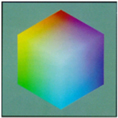Electronic Color Spaces
What are color spaces?
A color space is a mathematical representation of a set of colors. Many
operations perform video operations in different color spaces. Two fundamental
color models used are RGB (used in color computer graphics and color television)
and YUV or YCrCb (used in broadcast and television systems).
What is RGB color space?
RGB (Red Green Blue) is the color space used most commonly in color computer
graphics, color TV and color imaging. All of the color spaces in common
use can be derived from the RGB information supplied by devices like cameras
and scanners. RGB is the most prevalent choice for graphics frame buffers
because color CRTs (Cathode Ray Tubes) use red, green and blue phosphor
to create the desired color. Using proportions of red, green, and blue
that are scaled to a minimum and maximum values for each component (for
example, 0x00 through 0xFF, or 0.0 through 1.0), most colors in the visible
spectrum can be recreated, although not completely. This scheme is based
on the additive properties of color. It comprises 3, 8-bit color components,
red, green and blue.

What is YUV color space?
The YUV color space is the basic color space used by the PAL (Phase Alternation
Line), NTSC (National Television System Committee) and SECAM (Sequential
Couleur Ave Memoire or Sequential Color with Memory) composite color video
standards. It comprises 8-bit luminance (Y), 8-bit color difference component
(U) and 9-bit color difference component (V).

What is YCrCb color space?
YCrCb color space was developed as part of Recommendation ITU-R BT.601
during the development of a world-wide digital component video standard.
YcrCb is a scaled and offset version of the YUV color space. It comprises
8-bit luminance (Y) and two 8-bit chrominance (Cr, Cb) components. YcrCb
would be used in broadcast television and JPEG/MPEG schemes.
Why do we need different color spaces?
RGB is not very efficient when dealing with "real-world" images
as all three RGB components need to be of equal bandwidth to generate
any color. Therefore the same pixel depth and display resolution is needed
for each RGB component. For example, to modify the intensity or color
of a given pixel, three RGB values are read from the frame buffer, intensity
or color calculated, desired modifications performed, new RGB values calculated
and written back to the frame buffer. If the system had access to an image
stored in the intensity and color format, such as YUV or YCrCb, some processing
steps would be faster.
What is gamma correction?
Many devices use the cathode ray picture tube (CRT). The transfer function
of the CRT produces intensity that is proportional to some power (usually
about 2.5 and referred to as gamma) of the signal voltage. As a result,
high intensity ranges are expanded and low intensity ranges are compressed.
By "gamma correcting" the video signals before use, the intensity
output of the CRT is roughly linear and transmission-induced noise is
reduced.